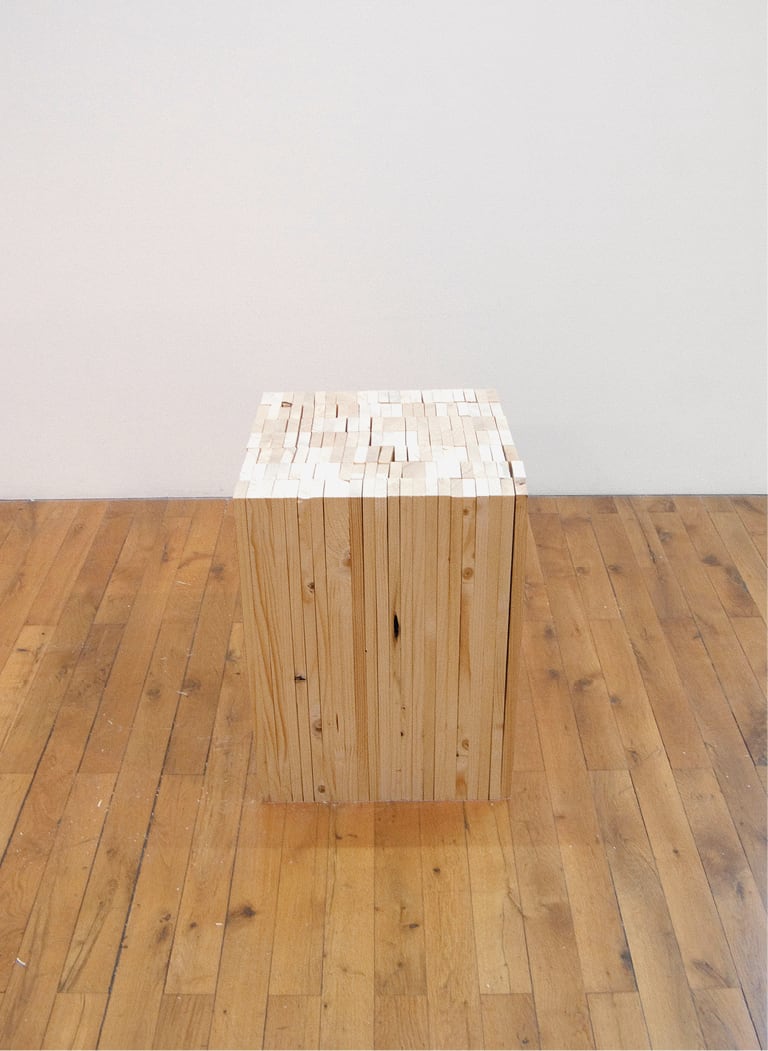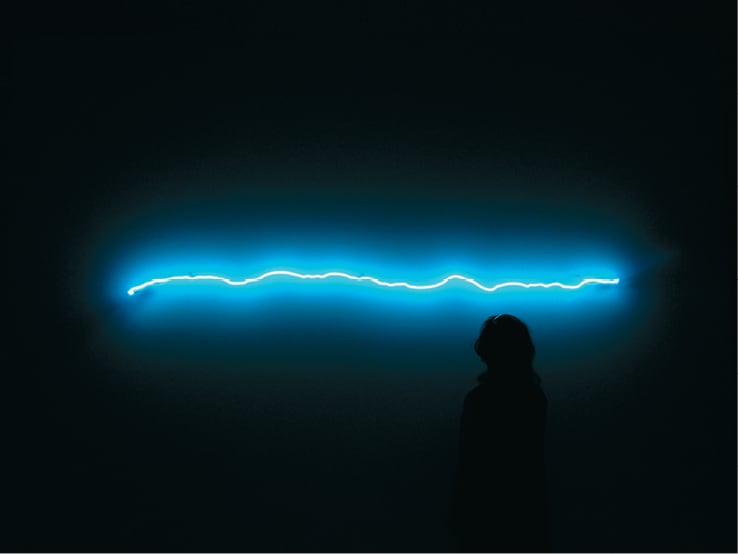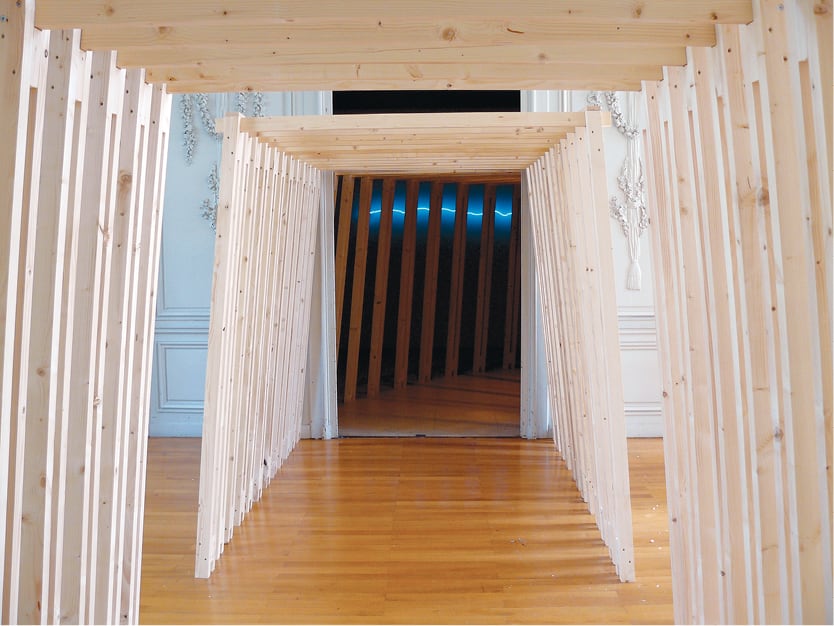
In 2006, French artist Marie-Jeanne Hoffner undertook a residency at Monash University and it was during this period that she and Melbourne-based artist Stephen Garrett discovered an affinity in their approaches to making art. In the same year, Garrett in fact built part of Hoffner’s work for her exhibition Heimlich — What Belongs To The House at Linden Centre for Contemporary Arts in St Kilda. In turn, Garrett then re-used the material from this structure to create his piece Blueprint (1:1) for the exhibition Interior Design curated by Hoffner for the Alliance Française in Melbourne. As a result of this cyclic dialogue, a formal collaborative partnership emerged between the two artists. Operating under the deliberately ambiguous pseudonym Garrett Hoffner, they created a ‘third artist’ and a hybrid territory in which to make art. Their first project Gold Rush was created for Espace Art Contemporain in La Rochelle, France, in June 2009. It was followed in the same year by After the Gold Rush in October for Conical in Melbourne and presented as part of the Melbourne International Arts Festival, Visual Art Program.
As individual practitioners, Garrett and Hoffner make sculptural site-responsive artworks, often involving conceptual and material investigations into architecture. Garrett focuses on interiors in architecture and the body in space, while Hoffner explores the folds, surface and skin of architecture. Based respectively in Melbourne and Paris, their partnership is directly affected by geographic distance and cultural shift. As such, the artists made a conscious decision to mediate these differences through the exploration of landscape — a concept not usually covered in their individual practices. Regularly using Skype and email, they continue their dialogue by sending source material, images and text back and forth. Whether exploring the geographic formation of islands, or Deleuzian desert island theory, these themes are combined with a research archive of human interventions into the landscape.
The exhibition rationales for both Gold Rush and After the Gold Rush came about at the same time and this is reflected through the continuation of themes and ideas from project to project. A small balsa wood structure — comprising scaffolding around a gold nugget — was displayed in a vitrine in La Rochelle. This piece became the prototype for the large-scale, crystalline sculpture in After the Gold Rush. Gold leaf, projections and built components are elements included in both projects, but the exhibitions were also created through the filter and history of each exhibition space. Espace Art Contemporain is a baroque bishop’s residence, retaining original interior decorative motifs, while Conical is a converted corner terrace in Fitzroy with exposed rafters, original fireplace and its own long history of facilitating artists and site-responsive practice.

What also links these projects is Garrett Hoffner’s use of imagery unearthed through their research — abandoned mining structures, walkways, entrances and scaffolding normally unseen or built underground. The large photographic canvas in After the Gold Rush depicts a mirrored stairway leading into a cave, clearly showing the structure itself and the architectural -intervention into the mountainside. Garrett Hoffner view these sites as points of penetration into the landscape — unnatural punctuations of surface and space that focus the landscape for a particular purpose while deleting all others. The photograph also represents a psychological landscape — like a Rorschach inkblot test — faces, skulls and creatures are made visible in shadowy abstraction.
Another part of Garrett Hoffner’s research into landscape and language includes compiled lists of words spelt identically in French and English that carry the same meaning in both languages. From this list, the artists created a text-based neon work for each exhibition. In La Rochelle they used the word ‘horizon’ and in Melbourne the word ‘desert’. The texts were constructed in wire first then stretched out between them, unmaking each as a word or a sign for something. Both a gesture and a spectre, these abstract linear pieces became the base forms for the light works. There is something poignant in the idea of the artists standing at either end of this unwound word, communicating through the wire like an abstract, string-telephone experiment, or holding a horizon between them. It is also representative of their broader approach to practice, generating and unfolding content with the intention of creating something new — a shared language and way of working. In the following series of questions they reflect on their recent collaborative history, the concepts and ideas they have explored, and their experience of making artwork together.
You have described Garrett Hoffner as the development of a new, single entity through which to make artworks. What does this entity enable you to do that wouldn’t otherwise be possible as individual artists?
The work that comes out of the collaborative process predominately emerges out of dialogue and negotiation around the central idea. We try hard to make sure that the space is separate from what we, as individual artists, would want to create. The process requires a lot in order to allow a loss of individual contour and for the emergence of a singular entity to arrive. We collaborate by trying to dissolve the barrier or distance between us as individual artists.
I have been trying for a while to create collaborative projects, and it’s always been hard to structure. With Stephen, it’s a different proposal, because we are trying to put aside the self. It’s difficult, especially because we cannot spend enough time together. This is a very interesting process for us. We both enjoy freeing ourselves in this project. It allows us to look at ourselves from a distance and to create forms that might not have come out otherwise. It’s also a playful working process. And we keep on exchanging back and forth — that makes it extremely exhilarating, exciting and rich.

Your collaborative practice doesn’t appear to be informed by conflict or disagreement. If this is the case, what allows for this affinity and as artists what is it that draws you together?
There is the right combination of affiliation and resistance between us. We have a mutual approach to how we individually work and use that to create this other persona for ourselves. That way we’re not just dealing with each other, but we are actually dealing with this ‘third person’ — the process has a distancing effect, allowing a more cohesive and collaborative process to evolve. We are both intrigued by the manner in which this is evolving — as its own practice — that perhaps Garrett Hoffner is real and we are just the managers.
Friendship, many correspondences in our way of thinking and relying on the space and the body in space. There is a good energy between us — there are barely any tensions and we put all our ideas together, come back and forth to them, one idea leading to another. The sense of space or maybe the relationship one has to the place is quite central in both our practices, as is the question about the nature of things and a curiosity. Actually, we are both Geminis, so that makes Garrett Hoffner a pretty complex character.
What are the challenges of being based in France and Australia respectively and facing physical and cultural disconnection from your subject and collaborator? In situ, your work demonstrates a thoughtful precision in dealing with these issues but, in the process of creating the work, how do you avoid superficial or clichéd observations of each other’s culture and their histories within the landscape?
I’m not sure we do avoid the clichéd viewpoint at all times, sometimes we play into those themes as an easy way into various subject matter. These are often distilled and reshaped to move them away from mere sophistry. The distance is a large issue for us in creating consistency but also the immediacy of working with someone all the time and developing ideas that way. It’s a lot more challenging through email and Skype!
It’s more like a channeled idea, the landscape contains us, we can’t contain it — we barely touch it. I feel fascinated by Australian history and territory. We are attracted to similar things, so that we can create works in situ as well as works about a wider concept — reading images and processing forms together.
The exploration of language is a central concern within your collaborative practice and is often the conceptual starting point for an artwork. How then does the use of language, in particular its translation between cultures, inform your work?
We became really interested in the discrepancy within the translation. We started looking for words that were the same in English and French. Curiously, all of these words were related to the landscape as well. Playing with those, breaking down the semiology, that’s where the neon works came from — forming these words that were the same in both languages and then literally pulling them, stretching them apart between us, allowing them to form the visual equivalent of their semiotic structure.
Being at the centre of who we are and how we communicate, our tendency to work around language became essential and almost like a private joke. We decided to find similar words. It could lead to an erasure of frontiers in some way, but it doesn’t. At least it’s being poetic in both languages … hopefully.
Human intervention into the landscape and the geological formation of islands are both concepts that have been variously explored within your work. In the context of cross-cultural collaboration, what is revealed or concealed through the exploration of these concepts?
These ideas represent both ends of the spectrum. One end is the cyclical development of an island, which is born through geological transition, at the other end is the same idea of development and transition but through inorganic means. The ability to create architectural structures deeply embedded in the landscape — the traditional mine with its wooden beams cutting deeply into the surface of the earth, holding everything back in order to tunnel deeper — has the internal logic of a land mass breaking away from the main land or volcanic eruption forming in the ocean. There is the idea of a pre-colonised landscape and the colonised or human intervention within that space.
I suppose it’s about finding a common ground between us. It would be a state of pre-colonisation in a way — where and when Australia wasn’t Australia … as it is now the sense of linkage to the place is a primal feeling — we are happy to question these themes as a way to question construction and deconstruction, within our practice as well as within a territory.
